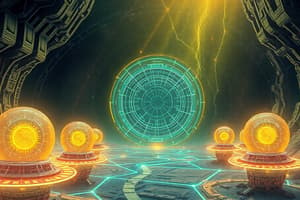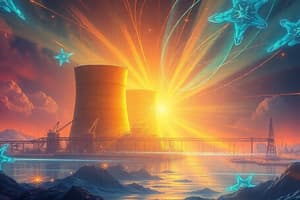Podcast
Questions and Answers
What is the main function of a scintillator in a scintillation detector?
What is the main function of a scintillator in a scintillation detector?
- Measure the size of the current pulse
- Absorb the energy of the incident particle and produce light (correct)
- Convert incident radiation into a current pulse
- Detect alpha, beta, and gamma particles
Which component of the scintillation detector is responsible for converting the energy of incident particles into a current pulse?
Which component of the scintillation detector is responsible for converting the energy of incident particles into a current pulse?
- Gamma radiation
- Photomultiplier tube
- Neutrons
- Scintillator material (correct)
What property of a scintillator allows it to emit light when an external charged particle enters?
What property of a scintillator allows it to emit light when an external charged particle enters?
- Proton detection
- Scintillation (correct)
- Neutron absorption
- Absorption of gamma radiation
In a scintillation detector, what is the role of the photomultiplier tube?
In a scintillation detector, what is the role of the photomultiplier tube?
How does the scintillator material in a scintillation detector respond to an external charged particle?
How does the scintillator material in a scintillation detector respond to an external charged particle?
Which of the following best describes the function of a scintillator in a scintillation detector?
Which of the following best describes the function of a scintillator in a scintillation detector?
What is the main role of a photomultiplier tube in a scintillation detector?
What is the main role of a photomultiplier tube in a scintillation detector?
What effect does an external charged particle have on a scintillator in a scintillation detector?
What effect does an external charged particle have on a scintillator in a scintillation detector?
In a scintillation detector, what is the primary function of the photomultiplier tube?
In a scintillation detector, what is the primary function of the photomultiplier tube?
What is the specific property of a scintillator that allows it to be used in a scintillation detector?
What is the specific property of a scintillator that allows it to be used in a scintillation detector?
Flashcards are hidden until you start studying
Study Notes
Scintillator in a Scintillation Detector
- Main function is to detect and measure ionizing radiation by converting the energy of incident particles into visible light.
- The scintillator emits light in response to an external charged particle entering its material, a property known as scintillation.
- Scintillation occurs when the material absorbs energy from charged particles, exciting its electrons and causing them to emit photons as they return to a lower energy state.
Energy Conversion and Detection Components
- The photomultiplier tube (PMT) is the component responsible for converting the emitted light from the scintillator into an electrical current pulse.
- When light photons hit the PMT, they are converted into a proportional current, enabling the measurement of radiation intensity.
Role of the Photomultiplier Tube
- The PMT amplifies the weak light signals emitted by the scintillator, making them detectable.
- It plays a crucial role in detecting low levels of radiation by providing high sensitivity and fast response times.
Interaction with External Charged Particles
- Upon interaction with an external charged particle, the scintillator generates flashes of light proportional to the particle's energy.
- Scintillator materials typically have a high atomic number to enhance their effectiveness in absorbing radiation and producing light.
Key Properties of Scintillators
- The ability to emit light when excited by radiation is the key characteristic that enables scintillators to be used in detectors.
- Fast response time and efficiency in light production are important factors that define a suitable scintillator for detection applications.
Studying That Suits You
Use AI to generate personalized quizzes and flashcards to suit your learning preferences.




